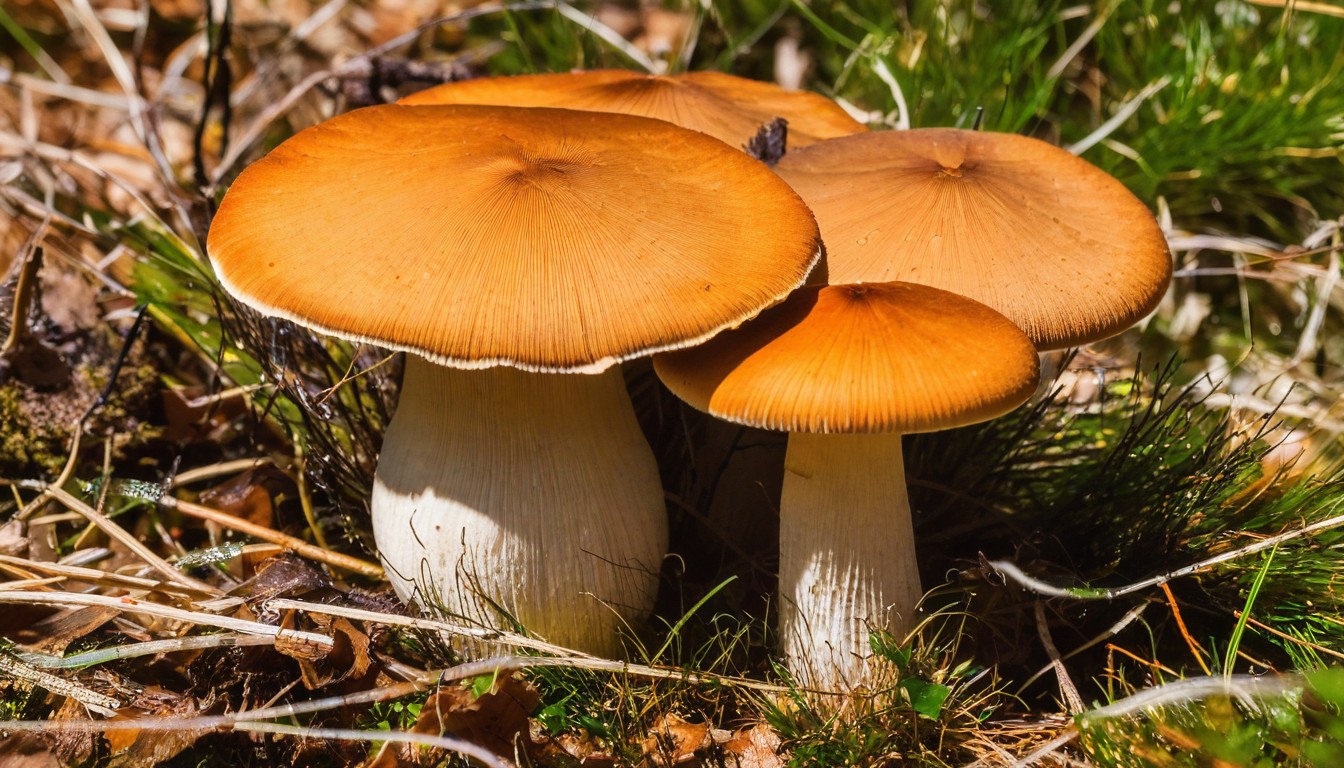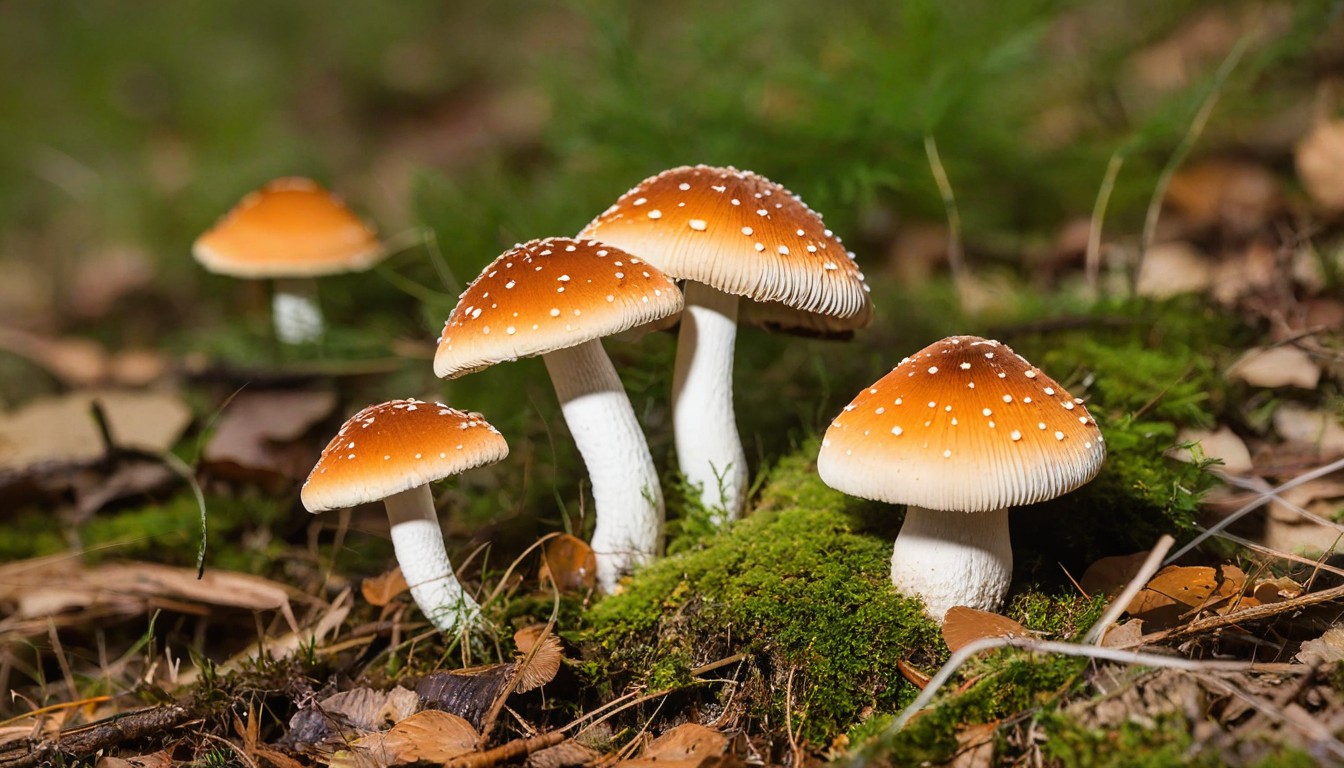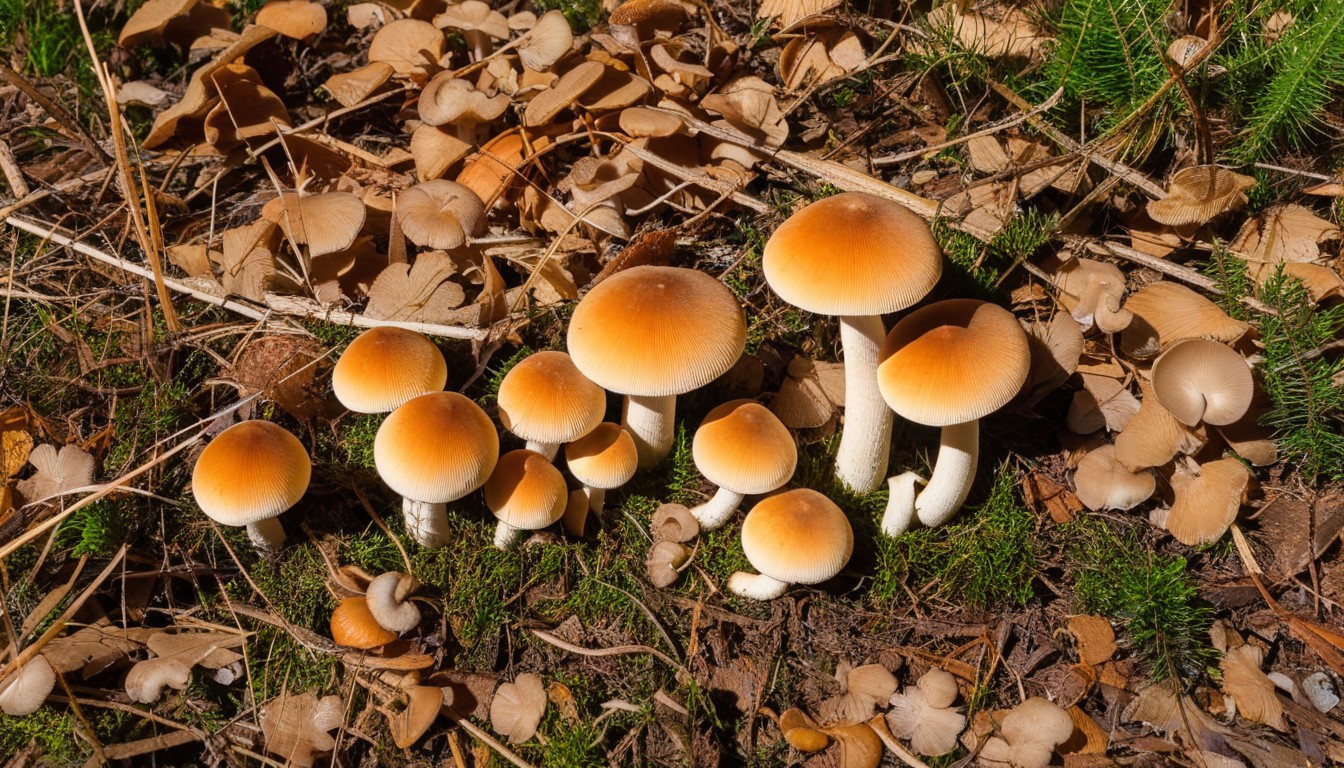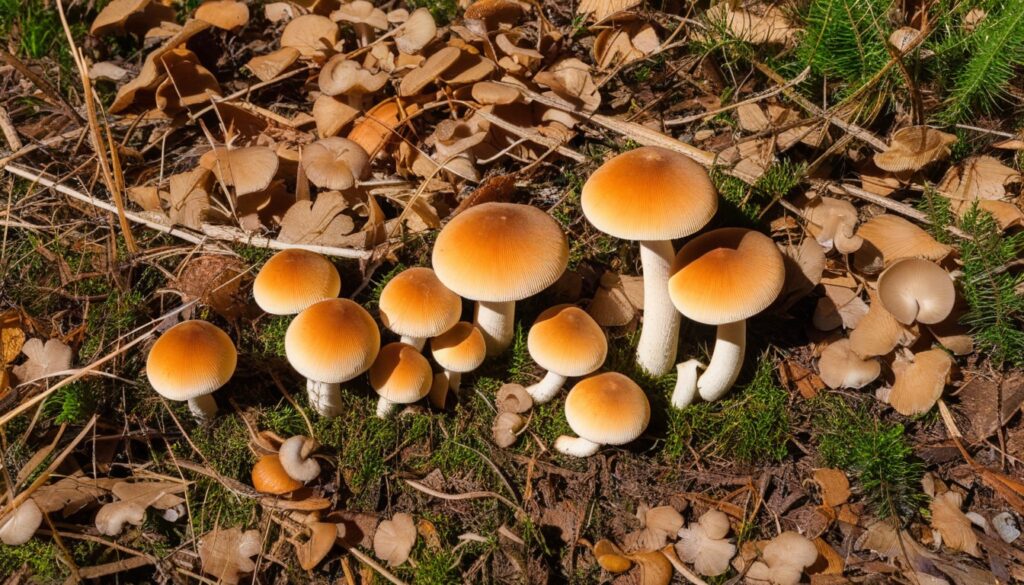Welcome to our guide on exploring common mushrooms found in Tennessee. The state of Tennessee boasts a rich diversity of mushroom species that are waiting to be discovered. In this guide, we will delve into the fascinating world of mushrooms found in Tennessee, including identification, edibility, medicinal uses, and more. Whether you’re a seasoned forager or a curious nature enthusiast, there’s plenty to explore in the world of common mushrooms in Tennessee.
Key Takeaways:
- Tennessee is home to a diverse range of mushroom species
- Learning how to identify common mushrooms in Tennessee is crucial for responsible foraging
- While some mushrooms are edible and have medicinal properties, others can be poisonous
- Mushrooms play a vital role in the ecosystem and contribute to the health of Tennessee’s forests
- With proper guidance and gear, mushroom foraging in Tennessee can be a rewarding and safe experience
Introduction to Tennessee Mushrooms
Welcome to the fascinating world of mushrooms in Tennessee! From the lush forests of the Appalachian Mountains to the rolling hills of the Tennessee Valley, the state is home to a diverse array of mushroom species.
In this section, we’ll provide an introduction to Tennessee mushrooms, including the common mushroom species found in the state and the important role they play in the ecosystem.
The Role of Mushrooms in the Ecosystem
Mushrooms are an essential part of the ecosystem, playing many important roles. They help to break down organic matter, making nutrients available to other plants and organisms in the environment. Some mushrooms form symbiotic relationships with trees, providing them with essential nutrients in exchange for carbohydrates.
Additionally, some mushrooms are even able to break down toxic substances in the environment, making them an important tool in environmental cleanup efforts.
Common Mushroom Species in Tennessee
There are over 1,000 species of mushrooms that have been identified in Tennessee, with many more waiting to be discovered. Some of the most common species found in the state include:
|
Mushroom Species |
Description |
|---|---|
|
Chanterelles |
Yellow-orange, trumpet-shaped caps with wavy edges. Known for their fruity aroma and meaty texture. |
|
Morels |
Conical, cone-shaped caps with a honeycomb-like texture. Highly prized for their earthy, nutty flavor. |
|
Oyster Mushrooms |
Irregularly shaped caps with white to grayish-brown gills. Have a mild, delicate flavor. |
|
Hen of the Woods |
Clustered, frilly caps with a ruffled appearance. Have a meaty, rich flavor. |
These are just a few examples of the many fascinating mushroom species found in Tennessee. As you venture into the world of mushroom foraging, keep an eye out for these and other varieties!
Identifying Common Mushrooms in Tennessee
With over 4,000 species of mushrooms found in Tennessee, identifying each one can be a daunting task. However, with a basic understanding of key characteristics, features, and growth patterns, anyone can learn to differentiate between common mushroom species in the state.
Mushroom Characteristics
Before attempting to identify a mushroom, it’s important to inspect its physical characteristics. Observe the cap, stem, and underside of the mushroom, taking note of color, texture, and shape. Most mushrooms can be identified using a combination of these factors.
Cap:
- Shape: Broad and flat or convex.
- Color: Varies greatly depending on species and can range from white to brown or even brightly colored.
- Texture: Smooth or scaly.
Stem:
- Shape: Straight or curved.
- Color: Varies greatly depending on species and can range from white to brown or even brightly colored.
- Texture: Smooth or with fine hairs.
Underside:
- Gills vs. pores: Look at the underside of the mushroom to see whether it has gills or pores. Gills are thin, flat structures that radiate like spokes from the center and are separated by narrow, sharp-edged spaces. Pores are small openings that allow spores to fall through.
- Spacing: For gilled mushrooms, look at the spacing between the gills, where they meet the stem.
Seasonal Differences
The time of year can also be a helpful factor in identifying mushrooms. Different species will fruit at different times depending on temperature, humidity, and rainfall. For example, Morels are typically found in the spring, whereas Chanterelles are commonly found in the summer and fall.
Resources
There are many resources available to help with Tennessee mushroom identification, including field guides, smartphone apps, and online forums. It’s important to consult several sources and get confirmation from an expert before consuming any wild mushrooms.
Note: Mushrooms can be harmful or deadly if consumed without proper identification. Always exercise caution when foraging and seek guidance from an experienced mushroom hunter or mycologist.
Common Mushrooms Found in Tennessee
|
Name |
Cap Color |
Stem Color |
Underside |
Season |
|---|---|---|---|---|
|
Chanterelle |
Yellow to orange |
Yellow |
Pores |
Summer – Fall |
|
Morel |
Brown |
White to cream |
Pits and ridges |
Spring |
|
Oyster Mushroom |
Gray to brown |
White to cream |
Gills |
Spring – Fall |
|
Honey Mushroom |
Tan to brown |
Tan to brown |
Veined gills |
Fall |
|
Shaggy Mane |
White to brown |
White to brown |
Black, ink-like substance |
Summer – Fall |
Edible Mushrooms in Tennessee

Foraging for edible mushrooms is a popular activity in Tennessee, with a range of delectable culinary options available once you know where to look. It’s important to ensure you only forage for mushrooms that are safe to eat. Let’s explore some of the edible mushrooms commonly found in Tennessee.
|
Mushroom |
Description |
Edibility |
Expert Tips |
|---|---|---|---|
|
Chanterelle |
Bright orange, vase-shaped cap with false gills. Found in hardwood forests and woodland areas. |
Edible and highly sought after for its fruity aroma and meat-like texture. |
Look for yellow to orange caps with a smooth texture. Avoid mushrooms with broken caps or insect damage. |
|
Oyster Mushroom |
Grayish, fan-shaped cap with white to light yellow gills. Commonly found on dead or dying trees. |
Edible and versatile, often used in soups, stir-fries, and sauces. |
Check for distinctive oyster-like shape with overlapping layers. Harvest when young and tender. |
|
Morel |
Honeycomb-like cap with pitted surface. Found in areas with rich soil and moisture. |
Edible and highly prized for their earthy flavor and meaty texture. |
Be careful when identifying, as morels can resemble poisonous mushrooms. Cook thoroughly before consuming. |
Remember to always positively identify each mushroom and avoid any species you cannot positively identify. Adhere to responsible foraging practices to ensure you do not harm the ecosystem or endanger yourself. Consult an expert or field guide if you’re unsure about identifying a mushroom.
Happy foraging!
Poisonous Mushrooms in Tennessee
As much as mushroom hunting can be an enjoyable activity, it comes with potential dangers, especially if you are not sure which mushrooms are safe to eat or touch. In Tennessee, there exist various poisonous mushrooms that can cause adverse reactions, and in worst-case scenarios, death.
The first step in avoiding such risks is to know how to identify poisonous mushrooms. Some common examples include the Amanita phalloides, also known as the Death Cap Mushroom, and the Galerina marginata, commonly referred to as the Deadly Galerina.
|
Poisonous mushroom name |
Symptoms |
|---|---|
|
Amanita phalloides |
Within 6 to 12 hours after ingesting the mushroom, individuals may experience vomiting, diarrhea, intense abdominal pain, and dehydration. These symptoms subside for a short period and may reoccur, causing liver damage and eventually, death. |
|
Galerina marginata |
Initial symptoms include abdominal pain, nausea, and vomiting. As the condition worsens, an individual may suffer from seizures, kidney failure, coma, or even death. |
It is vital to note that some poisonous mushrooms resemble edible ones, making identification difficult, even for experienced mushroom foragers. To be safe, always avoid consuming unfamiliar mushrooms. In case of accidental ingestion, seek immediate medical attention.
Wearing gloves and using a mushroom knife when collecting mushrooms can also help minimize the risk of contact with poisonous mushrooms. Additionally, proper cleaning and cooking of edible mushrooms are crucial in eliminating any toxins that might be present.
To avoid putting yourself or others in danger, it is essential to educate yourself about the poisonous mushrooms that grow in Tennessee, their habitats, and how to identify them. A reliable book, such as the North American Mushrooms field guide by National Audubon Society, is an excellent resource for learning about mushroom identification.
Medicinal Mushrooms in Tennessee

Mushrooms have been revered for centuries for their medicinal properties, and Tennessee is home to several species known for their health benefits. Here are some of the most notable medicinal mushrooms found in the state:
|
Mushroom Name |
Health Benefits |
|---|---|
|
Reishi |
Boosts immune system, reduces inflammation, relieves stress and anxiety |
|
Lion’s Mane |
Improves cognitive function, enhances nerve growth and regeneration |
|
Maitake |
Lowers blood sugar, enhances immune function, reduces cholesterol levels |
These mushrooms can be consumed as supplements, teas, or included in culinary dishes. While they offer numerous health benefits, it’s important to note that they should not be used as the sole treatment for any medical condition. Always consult with a healthcare professional before incorporating medicinal mushrooms into your diet.
Traditional cultures have long recognized the medicinal properties of mushrooms and have used them for centuries to aid in healing and overall wellness. By incorporating these beneficial fungi into our lives, we can experience their health-boosting effects firsthand.
Mushrooms and the Environment

Mushrooms are not only fascinating organisms but also play a crucial role in maintaining the health and balance of ecosystems in Tennessee. Fungi are essential decomposers in the environment, breaking down dead plant and animal matter and returning vital nutrients to the soil.
Their intricate network of underground mycelium threads also helps to create soil structure and maintain soil moisture, making it easier for plants to grow and preventing soil erosion. In addition, some fungal species form mutualistic partnerships with plants, sharing nutrients and enhancing plant growth.
The diversity of mushroom species in Tennessee contributes to the state’s unique biodiversity. With over 2,400 known species, the state is home to a rich variety of fungi that play a vital role in maintaining the health of local ecosystems.
The Health Benefits of Tennessee Fungi Biodiversity
The rich diversity of mushrooms in Tennessee has the potential to provide significant health benefits. Many fungal species have been found to have antibiotic, anti-inflammatory, and antioxidant properties that can boost immune function and reduce inflammation.
Some popular edible mushroom species found in Tennessee, such as the shiitake and oyster mushroom, also contain beta-glucans and other compounds that have been linked to improved cardiovascular health, lowered cholesterol levels, and better blood sugar control. Other medicinal mushrooms, such as reishi and chaga, have been used for centuries in traditional medicine to promote overall health and well-being.
Tennessee Fungi in Ecosystems
The ecological significance of fungi in Tennessee’s ecosystems cannot be overstated. Fungi are involved in a wide range of ecological processes, from decomposing organic matter to serving as keystone species in food webs.
In particular, mycorrhizal fungi form mutualistic partnerships with plants, exchanging soil nutrients for plant-derived sugars. These fungi are vital for plant growth and survival, making them an essential component of healthy ecosystems.
Overall, the study of Tennessee’s fungal biodiversity and the role of fungi in ecosystems is an essential area of research. Understanding the ecological functions of these organisms is crucial for identifying and mitigating threats to the environment and promoting sustainable land management practices.
Join us in exploring the fascinating world of common mushrooms in Tennessee and learn how these unique organisms contribute to the health and balance of local ecosystems.
Tips for Mushroom Foraging in Tennessee
Ready to embark on a mushroom foraging adventure in Tennessee? Follow these tips to maximize your chances of discovering some delicious and unique fungi:
- Pick the right season: Different mushroom species thrive during different seasons, so do your research before heading out to forage. Late summer and early fall are typically the best times to find mushrooms in Tennessee.
- Choose the right location: Look for areas with a lot of moisture and shade, such as near rivers, streams, and forests. Keep in mind that you’ll need permission to forage on private property.
- Learn mushroom identification: It’s important to be able to distinguish between edible and poisonous mushrooms. Take the time to learn about the common mushroom species in Tennessee and their key characteristics.
- Invest in quality gear: A mushroom knife, basket, and field guide are all essential tools for successful foraging. Wear sturdy shoes and clothing that can handle the outdoors.
- Forage responsibly: Only take what you need and avoid damaging the ecosystem. Leave some mushrooms behind so that they can continue to spread spores and grow in the future.
- Get permission: Always ask for permission before foraging on public or private land. Be respectful of property and follow local regulations.
By following these tips, you’ll be well on your way to a successful and enjoyable mushroom foraging experience in Tennessee.
Notable Mushroom Species in Tennessee

Tennessee is home to a phenomenal array of mushroom species, each with their unique characteristics and habitats. In this section, we will explore some of the most notable and fascinating mushroom varieties found in the state.
Chicken of the Woods Mushroom
The Chicken of the Woods mushroom is a vibrant, orange fungus that grows on dying or dead trees, particularly oaks. This mushroom is distinctive for its fan-shaped, overlapping caps and bright undersides. The Chicken of the Woods mushroom is also a popular edible mushroom, with a taste described as similar to chicken.
Reishi Mushroom
Another notable mushroom species found in Tennessee is the Reishi mushroom. This mushroom has been used for centuries in traditional Chinese medicine for its anti-inflammatory and immune-boosting properties. The Reishi mushroom is recognizable for its unique, kidney-shaped cap and glossy, reddish-brown coloration.
Chanterelle Mushroom
The Chanterelle mushroom is one of the most sought-after edible mushrooms in the world. These fungi are prized for their delicious, delicate flavor and firm, meaty texture. In Tennessee, Chanterelles can be found growing in damp, wooded areas, particularly near oak trees. These mushrooms have a distinctive trumpet-like shape and a bright yellow or orange color.
Hedgehog Mushroom
The Hedgehog mushroom is a small, delicate fungus that can be found growing on the forest floor in Tennessee. This mushroom is recognizable for its spiky, tooth-like projections on the underside of its cap instead of gills. Hedgehog mushrooms are a popular edible variety, with a slightly sweet flavor and tender texture.
Morel Mushroom
The Morel mushroom is a highly coveted edible mushroom found in Tennessee and other regions of the United States. These mushrooms grow in sandy soils under hardwood trees and have a unique, honeycomb-like appearance. Morel mushrooms are prized for their rich, earthy flavor and meaty texture, making them a popular ingredient in high-end cuisine.
|
Mushroom Species |
Distinct Characteristics |
Habitats |
|---|---|---|
|
Chicken of the Woods Mushroom |
Vibrant orange coloration, fan-shaped overlapping caps, and bright undersides. |
Grows on dying or dead trees, particularly oaks. |
|
Reishi Mushroom |
Kidney-shaped cap, glossy reddish-brown color. |
Can be found on a variety of trees, including oak and maple. |
|
Chanterelle Mushroom |
Trumpet-like shape, bright yellow or orange color. |
Grows in damp, wooded areas near oak trees. |
|
Hedgehog Mushroom |
Spiky tooth-like projections instead of gills, delicate texture. |
Found growing on the forest floor in Tennessee. |
|
Morel Mushroom |
Honeycomb-like appearance, meaty texture. |
Grows in sandy soils under hardwood trees. |
These are just a few examples of the notable mushroom species found in Tennessee. Take some time to explore the state’s diverse fungal landscapes and discover the fascinating world of mushrooms for yourself.
Cultivating Mushrooms at Home
Have you ever considered cultivating your own mushrooms at home? With the right tools and techniques, anyone can learn to grow these delicious fungi in the comfort of their own home. In Tennessee, home mushroom cultivation has become an increasingly popular hobby for those interested in exploring the world of mycology.
Choosing the Right Species
When it comes to cultivating mushrooms, the first step is to choose the right species. Some popular options for beginners include oyster mushrooms, shiitake mushrooms, and lion’s mane mushrooms. These species are known for their versatility and adaptability, making them great for home cultivation.
Creating Optimal Growing Conditions
Once you’ve chosen your ideal mushroom species, it’s time to create the optimal growing conditions. Mushrooms typically require a warm, damp, and dark environment to grow, so you may need to invest in some equipment to maintain these conditions. A grow bag or a growing kit can be a great option for beginners, while more advanced cultivators may choose to create their own growing chambers.
|
Equipment Needed for Home Mushroom Cultivation: |
|---|
|
Grow bag or growing kit |
|
Spawn or mushroom culture |
|
Substrate (such as sawdust, straw, or compost) |
|
Container |
|
Spray bottle |
Harvesting Your Mushrooms
As your mushrooms begin to grow, it’s important to monitor them carefully and harvest them at the right time. The best way to know when your mushrooms are ready for harvest is to watch for changes in their appearance and texture. Mushrooms should be harvested before the caps begin to open and release spores. You can use a sharp knife or scissors to cut the mushrooms off at the base of the stem.
Enjoying Your Homegrown Mushrooms
Once you’ve harvested your mushrooms, it’s time to enjoy the fruits of your labor! There are countless ways to prepare and serve mushrooms, from sautéing them with butter and garlic to using them in pasta dishes or on top of pizzas. Experiment with different cooking methods and flavor combinations to discover your favorite mushroom recipes.
With these tips in mind, you’ll be well on your way to cultivating your very own mushrooms at home in Tennessee. Happy growing!
Conservation Efforts and Mushroom Preservation in Tennessee
The rich and diverse fungal flora of Tennessee is under great threat due to habitat loss, climate change, and over-harvesting. As such, conservation efforts and mushroom preservation measures have become increasingly vital to protect and preserve this essential component of the local ecosystem.
Tennessee Fungi Conservation is a non-profit organization working tirelessly to conserve the state’s rare and endangered fungi species. Through educational programs, research initiatives, and collaborative efforts with conservation partners, they aim to raise public awareness and develop effective strategies to protect and preserve the state’s fungal diversity.
Projects and Initiatives
Some of the ongoing projects and initiatives by Tennessee Fungi Conservation include:
|
Project Name |
Description |
|---|---|
|
Southern Appalachian Mushroom Project |
An extensive study on the various mushroom species found in the Southern Appalachian region to understand their ecological significance and preserve the rare and endangered ones |
|
Eastern Wild Mushroom Conservation |
A collaborative effort with the Eastern Band of Cherokee Indians to conserve the rare mushroom species of the region and promote sustainable foraging practices |
|
Mushrooms of the Smokies |
An educational program designed to raise awareness about the essential role mushrooms play in the Great Smoky Mountains National Park |
These projects elucidate the importance of preserving Tennessee’s fungal diversity for sustainable ecological functioning and the benefits it provides to human health.
Preserving Mushrooms in Tennessee
Several measures can be taken to preserve the fungi population in Tennessee, including:
- Conserving habitats of wild mushroom species through forest protection measures
- Encouraging responsible and ethical mushroom foraging practices to reduce over-harvesting
- Supporting initiatives and organizations dedicated to conserving Tennessee’s fungal diversity
- Developing mushroom cultivation practices to reduce wild mushroom harvesting and protect the wild populations
Through these measures, we can all play a part in preserving Tennessee’s fungal diversity for future generations to enjoy.
Conclusion
Exploring the world of common mushrooms in Tennessee is a rewarding experience for anyone interested in nature and the environment. From identifying and foraging edible mushrooms to discovering the medicinal properties of certain species, there is a wide range of exciting opportunities to be discovered.
With expert tips for mushroom foraging and home cultivation, you can learn to appreciate and enjoy the unique qualities of Tennessee’s mushroom varieties. And with ongoing efforts dedicated to their conservation and preservation, you can do your part in protecting these vital components of our natural environment.
So, why not take a journey into the world of common mushrooms in Tennessee today? You never know what fascinating fungi you may discover.
FAQ
What types of mushrooms can be found in Tennessee?
Tennessee is home to a wide variety of mushrooms, including species such as morels, chanterelles, oyster mushrooms, and shaggy mane mushrooms, among others.
How can I identify common mushrooms in Tennessee?
To identify common mushrooms in Tennessee, it is important to observe their physical characteristics, such as color, shape, cap texture, gill arrangement, and spore color. Additionally, using a reliable field guide or consulting with an experienced mushroom enthusiast can help in accurate identification.
Are there any edible mushrooms in Tennessee?
Yes, there are several edible mushrooms that can be found in Tennessee, including morels, chanterelles, hen-of-the-woods, and chicken-of-the-woods. However, caution must always be exercised when foraging for wild mushrooms, as some species can be toxic.
What are the potential risks of foraging for mushrooms in Tennessee?
The main risk of foraging for mushrooms in Tennessee is the potential misidentification of poisonous species, which can lead to serious illness or even death. It is crucial to be knowledgeable about mushroom identification or to forage with an experienced guide to minimize these risks.
Can I grow mushrooms at home in Tennessee?
Absolutely! Growing mushrooms at home in Tennessee is a rewarding and relatively simple process. There are various methods, such as using mushroom kits or cultivating mushrooms from spores with the right growing conditions and techniques.
Are there any conservation efforts dedicated to preserving mushroom species in Tennessee?
Yes, there are ongoing conservation efforts in Tennessee aimed at preserving the diverse mushroom species found in the state. Organizations and initiatives work towards protecting mushroom habitats, educating the public about their importance, and promoting sustainable foraging practices.

